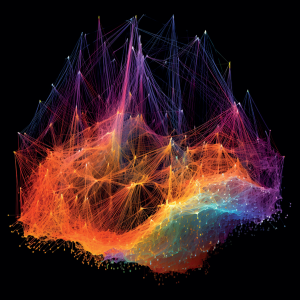We continue our yearly tradition of highlighting our favorite cover suggestions that did not make it as covers at Nature Computational Science.
Every year, we receive many excellent cover suggestions from our authors, which are not only aesthetically appealing, but that also nicely depict the research behind their corresponding manuscripts. Unfortunately, as we select only one cover per issue, many of these cover suggestions go unseen by our readers.
In an effort to bring some of these images to light, every year we highlight our favorite suggestions that were not chosen as Nature Computational Science covers. Here are our favorite images from 2023.

Credit: Luca Cappelletti
The first image was submitted by Giorgio Valentini and colleagues for their paper on GRAPE1, a software resource for large graph processing and embedding. The image represents an artistic rendition of a complex graph, by combining multiple graphs with varying topologies, in order to visually illustrate the main topic of the manuscript.

Credit: Melany Margarita Ryan
Another cover runner-up was submitted by Martín Larocca et al., related to their study2 on the hardness of training quantum neural networks. According to the authors, the artwork depicts a curved wire frame grid representing the optimization landscape for a quantum neural network. The main theoretical result of the paper uncovers the presence of a computational phase transition in the optimization landscape as a function of the number of parameters. Practically speaking, this allows quantum machine learning practitioners to better estimate the critical number of parameters required to overparameterize a model, thus potentially leading to better-designed circuit architectures.

Credit: peepo / iStock / Getty Images Plus
Finally, another favorite cover suggestion came from Nima Aghaeepour and colleagues for their paper3 on an algorithm that enables faster construction of large correlation networks for unraveling connections in high-dimensional biological data. The suggested image depicts an increasingly connected network, with the goal of representing how the authors’ proposed method is able to calculate a correlation network to the degree of approximation desired by the user.
These images, of course, represent just a fraction of the interesting and important science performed by our authors, as well as their creativity. We look forward to seeing which artistic suggestions are submitted throughout this year!
References
-
Cappelletti, L. et al. Nat. Comput. Sci. 3, 552–568 (2023).
Google Scholar
-
Larocca, M. et al. Nat. Comput. Sci. 3, 542–551 (2023).
Google Scholar
-
Becker, M. et al. Nat. Comput. Sci. 3, 346–359 (2023).
Google Scholar
Rights and permissions
Reprints and permissions
About this article
Cite this article
Cover runners-up of 2023.
Nat Comput Sci 4, 1 (2024). https://doi.org/10.1038/s43588-024-00592-w
-
Published: 29 January 2024
-
Issue Date: January 2024
-
DOI: https://doi.org/10.1038/s43588-024-00592-w
